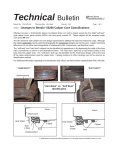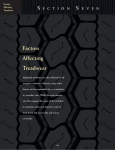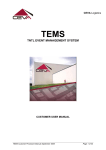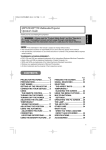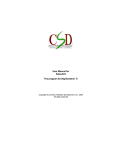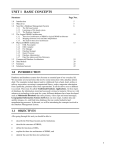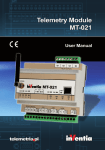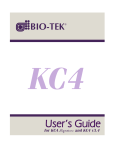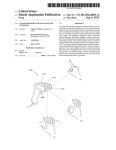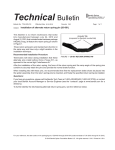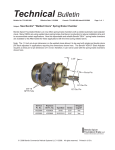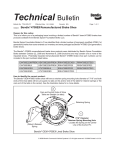Download spicer lite, aluminum steering
Transcript
Table of Contents . . . . . . . . . . . . . . . . . . . . . . . . . . . .iii End Fittings – Pinch Bolt Style . . . . . . . . . . . . . . . . . . .7 End Fittings – Companion Flange/Flange Yoke Style . . .9 Universal Joints . . . . . . . . . . . . . . . . . . . . . . . . . . . . . .9 Slip Member Assembly . . . . . . . . . . . . . . . . . . . . . . . .11 Lubrication . . . . . . . . . . . . . . . . . . . . . . . . . . . . . . . .13 Recommended Lubricants . . . . . . . . . . . . . . . . . . . . .15 Grease Compatibility . . . . . . . . . . . . . . . . . . . . . . . . .15 Lubrication Intervals Universal Joints . . . . . . . . . . . . .16 Lubrication Procedures Universal Joints . . . . . . . . . . .17 Lubrication Procedures Slip Member Assembly . . . . .17 Removal . . . . . . . . . . . . . . . . . . . . . . . . . . . . . . . . . .20 Removal Procedures For Aluminum Steering Shaft (Intermediate Shaft) . . . . . . . . . . . . . . . . . . . . . . . . . .21 Removal Procedures For Universal Joints . . . . . . . . . .22 Removal Procedures For Damaged Slip Member Boot . .27 Installation . . . . . . . . . . . . . . . . . . . . . . . . . . . . . . . .30 Installation Procedures For End Fittings . . . . . . . . . . .31 Installation Procedures For Universal Joints . . . . . . .33 Installation Procedures For Slip Member Boot . . . . . .39 Installation Procedures For Aluminum Steering Shaft (Intermediate Shaft) . . . . . . . . . . . . . . . . . . . . . . . . . .43 Glossary . . . . . . . . . . . . . . . . . . . . . . . . . . . . . . . . . .46 Appendix . . . . . . . . . . . . . . . . . . . . . . . . . . . . . . . . .48 iii TABLE OF CONTENTS Inspection . . . . . . . . . . . . . . . . . . . . . . . . . . . . . . . . . .6 INSPECTION SPICER LITE® ALUMINUM STEERING SHAFT (INTERMEDIATE SHAFT) INSPECTION 6. NEVER stand on an aluminum steering shaft (intermediate shaft) or use it as a leverage bar. See notification decal (reproduced below) on aluminum steering shaft (intermediate shaft). Before You Get Started This manual is intended to be a supplement to your original equipment vehicle manufacturers' service manual. For complete detailed Spicer aluminum steering shaft (interme- NOTICE/AVISO/AVIS diate shaft) maintenance procedures use this manual. NO STEP NO STEP NO STEP For Service and Safety requirements see Spicer Service Manual 3264-SLSTRG or www.dana.com NÃO PISAR NÃO PISAR NÃO PISAR Para informações sobre manutençäo e exigências de seguranca Veja o Manual de Serviços Spicer 3264-SLSTRG ou www.dana.com NO PISAR NO PISAR NO PISAR Para informaciones de mantenimiento y requisitos de seguridad Vea el Manual de Servicios Spicer 3264-SLSTRG o www.dana.com NE PAS APPUYER NE PAS APPUYER NE PAS APPUYER Vou les exigences d’entretien et de sécurité Dans le manuel de service Spicer n˚ 3264-SLSTRG Ou: www.dana.com Note - Spicer Lite aluminum steering shafts (intermediate shafts) are found on vehicles throughout the world. This INSPECTION manual includes international terminology. The international terms have been highlighted in teal. Caution - Under no circumstances should an individual attempt to perform aluminum steering shaft (intermediate shaft) service and/or maintenance procedures for which he or she has not been trained or does not have the proper tools and equipment. w See warning, below. 7. NEVER make any modifications to an aluminum steering shaft (intermediate shaft) that were not original to the design of the product. W WARNING Failure to take common-sense, precautionary measures when working on a vehicle could result in property damage, personal injury or death. In order to avoid property damage, personal injury or death, you must: 8. NEVER USE an aluminum steering shaft (intermediate shaft) in non-power steering applications. w See warning, below. 1. ALWAYS wear safety glasses when performing mainte- Spicer Lite aluminum steering shafts (intermediate shafts) are to be used only in original equipment vehicle manufacturers’ applications. Failure to do so can result in impaired steering and possible loss of vehicle control, which can result in property damage, personal injury or death. W WARNING nance or service. Failure to wear safety glasses could result in personal injury, partial or complete vision loss. 2. NEVER attempt to remove an aluminum steering shaft (intermediate shaft) from a vehicle while the engine is running. Be sure that the vehicle’s engine is off, and keys are removed from ignition. 9. NEVER use an aluminum steering shaft (intermediate shaft) in a cab over application. w See warning, above. 10. NEVER use an aluminum steering shaft (intermediate shaft) in a power-take-off (PTO) application. 3. NEVER go under or work on a vehicle that is not on a level or flat surface. 11. NEVER high-pressure wash aluminum steering shaft (intermediate shaft) u-joints or booted slip member with degreasing solvent or water. 4. NEVER remove an aluminum steering shaft (intermediate shaft) without blocking the vehicle’s wheels. 12. NEVER replace only one component of the slip member assembly (yoke shaft or slip yoke). 5. NEVER heat an aluminum steering shaft (intermediate shaft) component or use a hammer on the aluminum components of the steering shaft to remove it from the vehicle. 6 1. Check all input and output end fittings for looseness in the spline connection. Grasp the end fitting with both hands. Try to move it vertically and horizontally to feel any looseness. (See photo 2 below.) There should NOT be any movement in the end fittings relative to the input or output shaft to which they are connected. w See warning, below. Spicer Lite aluminum steering shafts (intermediate shafts) should be carefully inspected at recommended original equipment vehicle manufacturers’ service intervals and/or at Spicer recommended lubrication intervals, as shown in table A, below. Be sure to follow ALL inspection procedures described in this manual. W WARNING Note - The following procedures are to be performed prior to any lubrication of the universal joints. The addi- Failure to replace damaged aluminum steering shaft (intermediate shaft) components can cause aluminum steering shaft (intermediate shaft) failure. Failure of an aluminum steering shaft (intermediate shaft) can result in impaired steering and possible loss of vehicle control, which can result in property damage, personal injury or death. tion of lubricant can mask the looseness in a component that is beginning to show wear and may be in need of replacement. Required Tool • Spicer Steering Wear Indicator Part Number STWI-2 (See photo 1) 1-800-826-HELP (U.S. only) (For proper tool usage instruction – refer to Appendix A.) If looseness is evident, replacement of the end fitting is necessary. For proper end fitting replacement procedures, refer to the removal and installation sections of this manual. Photo 2 Photo 1 UNIVERSAL JOINT MAXIMUM LUBRICATION INTERVALS SERIES SPL 6 (relubeable style) CITY ON-HWY. LINEHAUL OFF-HWY. 25,000 Mi. 50,000 Mi. 50,000 Mi. 25,000 Mi. 40,000 Km 80,000 Km 80,000 Km 40,000 Km or or or or 3 Months 6 Months 6 Months 3 Months (whichever comes first) (whichever comes first) (whichever comes first) (whichever comes first) Linehaul is defined as 100% of operation time on smooth concrete or asphalt. Off-highway is defined as all applications requiring more than 10% of operating time on gravel, dirt or unpaved roads. City is defined as all applications that require a minimum of 90% of operation time within city limits. On-highway is defined as all applications requiring less than 10% of operating time on gravel, dirt or unpaved roads. Table A 7 END FITTING INSPECTION END FITTINGS PINCH BOLT STYLE ALUMINUM STEERING SHAFT (INTERMEDIATE SHAFT) INSPECTION PROCEDURES 2. Visually inspect both end fittings of the steering shaft for looseness or a gap at the pinch bolts and/or nuts. Also check to be sure the pinch bolts and/or nuts are not missing. (See photo 3.) If any of these situations are evident, inspect the male splined shaft for wear or damage. (See photo 4.) If the male shaft splines are worn or damaged, both the male shaft and end fitting must be replaced. w See warning, below. pinch bolt no gap forging width nut no gap END FITTING INSPECTION W WARNING Photo 3 Failure to replace damaged aluminum steering shaft (intermediate shaft) components can cause aluminum steering shaft (intermediate shaft) failure. Failure of an aluminum steering shaft (intermediate shaft) can result in impaired steering and possible loss of vehicle control, which can result in property damage, personal injury or death. For proper end fitting replacement procedures, refer to the removal and installation sections of this manual. For proper male splined shaft replacement procedures, replace in accordance with the original equipment vehicle manufacturers’ replacement procedures. Photo 4 W WARNING Failure to torque pinch bolts and/or nuts to required specifications can result in failure of the aluminum steering shaft (intermediate shaft). Failure of an aluminum steering shaft (intermediate shaft) 3. If no looseness or damage is evident, re-torque pinch bolts to proper torque specifications. (See table B, below.) can result in impaired steering and possible loss of vehicle control, which can result in property damage, personal injury or death. PINCH BOLT* AND/OR NUT TORQUE SPECIFICATIONS KIT # BOLT BOLT LENGTH WRENCH SIZE FOR BOLT FOR NUT NUT WRENCH SIZE BOLT HOLE DRY TORQUE FOR END YOKE WITH DIAMETER NM FT.LB. FORGING WIDTH OF*** 211269X included 2" 9/16" included 9/16" 3/8" 30-35 40-48 1.500" 211270X included 1.75" 9/16" included 9/16" 3/8" 30-35 40-48 1.125" & 1.25" 211271X included 2" 5/8" included 11/16" 7/16" 46-55 63-75 1.500" 211272X included 1.75" 5/8" included 11/16" 7/16" 46-55 63-75 1.125" & 1.25" 211273X included*† 1.25" 5/8" not required – 7/16" thread dia. 46-55 63-75 1.125" w/threads in yoke 211274X included 2.125" 5/8" included 11/16" 7/16" 46-55 63-75 1.620" *Aluminum steering shaft (intermediate shaft) end fitting pinch bolts are to be S.A.E. grade eight. Nuts for pinch bolts are to be selflocking with a full nylon insert, serrated washer seat or upset threads. An S.A.E. grade five hex nut used in conjunction with a split lock washer is also acceptable. Do not use inferior grade bolts. Note - When specified, use the original equipment vehicular manufacturers’ recommended pinch bolts and/or nuts. If no original equipment vehicle manufacturers’ specification is given, use the Spicer recommended hardware. (See table B, above.) See warning, above. w *†Bolt must have self-locking feature. ***See photo 3, above Table B 8 UNIVERSAL JOINTS END FITTINGS COMPANION FLANGE/FLANGE YOKE STYLE steering shaft (intermediate shaft), check for excessive the spline connection. Grasp the end fitting with both circumferential (backlash) looseness of the universal joint hands. Try to move it vertically and horizontally to feel any across the yoke lug ear span. (See photo 5 and Appendix.) looseness. There should NOT be any movement in the end Try to rotate the shaft back and forth to indicate any fittings relative to the input or output shaft to which they looseness. There should never be more than .011 in. are connected. (.28 mm) movement in the universal joint kit relative to w See warning, below. W WARNING the inboard and outboard yokes. If looseness is greater Failure to replace damaged aluminum steering shaft necessary. than stated above, replacement of the universal joint kit is (intermediate shaft) components can cause aluminum steering w See warning, step 1, left. shaft (intermediate shaft) failure. Failure of an aluminum steering shaft (intermediate shaft) can result in impaired steering and possible loss of vehicle control, which can result in property damage, personal injury or death. 2. Visually inspect all companion flange/flange yoke bolts and nuts (if applicable) for looseness, wear or damage. If bolts or nuts have looseness, wear or damage, replacement of the companion flange and flange yoke is necessary. w See warning, above. Photo 5 For proper replacement procedures for bolts, nuts, com- Refer to the removal and installation sections of this man- panion flange and flange yoke, refer to the removal and ual for proper universal joint kit replacement procedures. installation sections of this manual. 3. If no looseness or damage is evident, re-torque companion flange/flange yoke bolts and nuts (if applicable) to required specifications. (See table C, below.) COMPANION FLANGE/FLANGE YOKE BOLT AND NUT TORQUE SPECIFICATIONS WRENCH SIZE 1/2" DRY TORQUE NM FT. LB. 22-26 30-35 Table C 9 UNIVERSAL JOINT INSPECTION 1. Using the STWI-2 dial indicator, mounted to aluminum 1. Check all input and output end fittings for looseness in 4. If the grease zerk (nipple) fitting is loose, tighten to snug. Continue to tighten until grease zerk (nipple) fitting is oriented for easy lubrication. Tighten to (31-55 in. lbs.) (1.9-3.4 Nm). (See table D, below.) UNIVERSAL JOINT GREASE ZERK (NIPPLE) FITTING SPECIFICATIONS500 .375 SERIES SPL6 snap ring UNIVERSAL JOINT INSPECTION Table D Photo 6 2. Visually check for damaged, severely corroded, or missing snap rings in both universal joint kits. (See photo 6.) If any snap rings are damaged, severely corroded or missing, replacement of the universal joint kit is necessary. w See warning, below. W WARNING Failure to replace damaged aluminum steering shaft (intermediate shaft) components can cause aluminum steering shaft (intermediate shaft) failure. Failure of an aluminum steering shaft (intermediate shaft) can result in impaired steering and possible loss of vehicle control, which can result in property damage, personal injury or death. Refer to the removal and installation sections of this manual for proper universal joint kit replacement procedures. 3. Visually inspect all the universal joint kits for the presence of grease zerk (nipple) fittings (if applicable). Grease zerk (nipple) fittings should not be missing, loose or fractured. If the grease zerk (nipple) fitting is missing or fractured, the universal joint kit must be replaced. w See warning, above. Refer to the removal and installation sections of this manual for proper universal joint kit replacement procedures. 10 GREASE ZERK (NIPPLE) FITTING ZERK (NIPPLE) TORQUE P/N NM 500175-2 1.9-3.4 IN.LB. 31-55 Refer to the removal section of this manual for proper SLIP MEMBER ASSEMBLY aluminum steering shaft (intermediate shaft) assembly replacement procedures. 1. Using the STWI-2 dial indicator, as illustrated, check (backlash) looseness. (See photo 7.) Using both hands, 2. Using the STWI-2 dial indicator, as illustrated, check the one on each side of the gage, apply direct torque to the slip member assembly for excessive radial (broken back) shaft by twisting the shaft in opposite directions as illus- looseness. (See photo 8.) Grasp the aluminum steering trated in photo 7, below. Total indicator travel should not shaft (intermediate shaft) and apply a load of five pounds exceed .040 in. (1.0 mm). If looseness, as read on dial (2.27 kgs.) to the shaft and perpendicular to dial indicator indicator, is greater than stated above, replacement of the face. T Then apply a load of five pounds 180 degrees complete aluminum steering shaft (intermediate shaft) opposite to the shaft. assembly is necessary. w See warning, below. T W WARNING Tip Loop a wire or plastic zip tie around the shaft, between the boot and the smaller clamp of STWI – 2 gage. Using a spring scale (e.g. fish scale) pull on loop to five pounds. Aluminum steering shaft (intermediate shaft) slip member components (yoke shaft and slip yoke) are matched sets. NEVER replace only one component of the slip member Total indicator travel should not exceed .060 in. (1.5 mm). assembly (yoke shaft or slip yoke). Replacing only one member If looseness, as read on dial indicator, is greater than of the slip member assembly can result in impaired steering stated above, replacement of the complete aluminum and possible loss of vehicle control which can result in steering shaft (intermediate shaft) assembly is necessary. w See warning, step 1. property damage, personal injury or death. Photo 7 Photo 8 11 SLIP MEMBER INSPECTION the slip member assembly for excessive circumferential 3. Check for damaged or missing boot and/or clamps. 4. Check to be sure the welch plug is not loose, missing (See photo 9.) Make sure the boot is properly clamped or damaged. (See photo 10.) If the welch plug is loose, and square to the shaft and no looseness or damage is missing or damaged, replacement of the complete alu- apparent. Check to make sure boot clamps are properly minum steering shaft (intermediate shaft) assembly is necessary. w See warning, step 3. seated. If any looseness or damage is evident or boot clamps are not properly seated, replacement of the slip member boot is necessary. w See warning, below. 5. Check the aluminum steering shaft (intermediate shaft) for dents in the aluminum and for damage to the lug ear SLIP MEMBER INSPECTION Refer to the removal and installation sections of this man- shoulder. If either of these situations are evident, replace- ual for proper slip member boot replacement procedures. ment of the complete aluminum steering shaft (intermedi- w See warning, below. ate shaft) assembly is necessary. w See warning, step 3. W WARNING Refer to the removal and installation sections of this Failure to replace damaged aluminum steering shaft (interme- manual for proper aluminum steering shaft (intermediate diate shaft) components can cause aluminum steering shaft shaft) assembly replacement procedures. (intermediate shaft) failure. Failure of an aluminum steering shaft (intermediate shaft) can result in impaired steering and possible loss of vehicle control, which can result in property damage, personal injury or death. welch plug Photo 9 Photo 10 12










